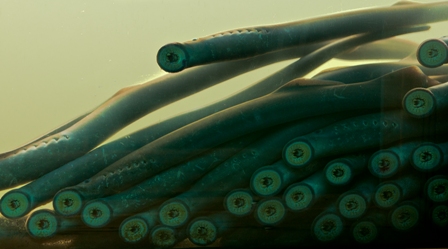April 17, 2015: Pesticides, mercury and flame retardants found in larvae and adult Pacific lamprey could be one of the causes of their decline, according to a recent study.
With their round, thin and flexible body, Pacific lamprey look like eels. But they are really a kind of fish. They existed well before the dinosaurs and were abundant throughout the Columbia River Basin in the same areas as salmon, with numbers in the millions.
Find out about the effort to conserve these ancient fish by clicking on this video.
The lamprey can reach 30 inches in length and weigh more than a pound. Its mouth is adapted for sucking and clinging to rocks, which is important for conserving energy while they are negotiating swift currents. Compared to salmon, lamprey are poor swimmers, but they still can travel great distances in a short time.
Lamprey are culturally important to indigenous people throughout their range, and play a vital role in the ecosystem as food to mammals, fish and birds, for nutrient cycling and storage, as well as a prey buffer for other species.

Lampreys spend most of their life as small, worm-like animals in stream sediment, feeding on algae and small organisms. After five to seven years, they mature and migrate out to the ocean. They live in the ocean for two years or so, where they mature into adults and are parasitic on larger fish and marine mammals. Like salmon, the lamprey then swim back to freshwater, where they spawn in areas similar to salmon. Watch a lamprey digging a redd (nest). They die after spawning, returning their sea nutrients to the stream for other species’ benefit.
Pacific lamprey's rate of decline has been much greater than that of salmon, and today just a few thousand migrate over Bonneville Dam each year. Factors that have led to their decline include threats at all stages of their life, including dams, poor water quality, predation by nonnative species, habitat loss and degradation, decline in prey, ocean conditions, dredging and dewatering.